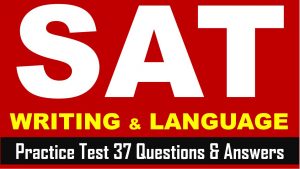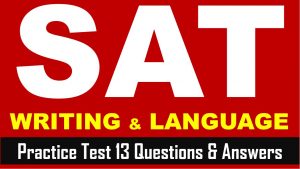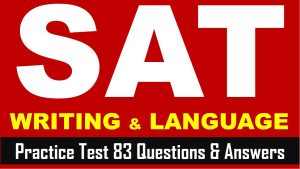Hi SAT Aspirants, welcome to AKVTutorials. As you know SAT (Scholastic Assessment Test) is a standard test, used for taking admission to undergraduate programs of universities or colleges of United States. SAT is developed and published by the College Board, an organization in United States, administered by the Educational Testing Service. Therefore, you need to do practice on SAT Reading Section, SAT Writing and Language Section. In this article, you will get SAT Writing and Language Practice Test Paper 61 AMBIPi.
Instruction:
- In the passage below is accompanied by a number of questions.
- For some questions, you need to think how the passage might be revised to improve the expression of ideas.
- For other questions, you will consider how the passage might be edited to correct errors in sentence structure, usage, or punctuation.
- Some questions will direct you to an underlined portion of a passage.
- Other questions will direct you to a location in a passage or ask you to think about the passage as a whole.
SAT Writing & Language Section Passage
SAT Writing and Language Practice Test Paper Passage Title: False or False: The Question of Falsifiability.
What is the difference between science and pseudoscience? According to Karl Popper, one of the most 1 potent philosophers of the twentieth century, it is a matter of falsifiability. He claimed that in order to be considered truly scientific, a hypothesis or theory must be capable of being proven false. 2 Next, he decided to make an assertion: l Popper offered a new perspective on the distinction between science and pseudoscience.
In a 1953 lecture at Cambridge University, Popper shared that the concept of falsifiability had first occurred to him more than thirty years earlier, 3 when he was pondering and considering Einstein’s theory of gravitation and Freud’s psychoanalytical approach. Popper realized that Freud’s approach has great “explanatory power,” because psychoanalysis can be applied to completely opposite behavior patterns with equal aptness. Although this flexibility might seem valuable, Popper argued that a theory which cannot be proven false—one which can ‘adapt’ to any critical environment—is not science but pseudoscience. The critical component of a scientific theory is the element of risk; 4 its value lies in predictive rather than explanatory power.
5 Einstein’s theory of gravitation was scientific because it made concrete predictions about what we should observe in the future, and therefore could be falsified if inconsistent 6 to these observations. Popper’s choice of falsifiability as the line of demarcation between science and pseudoscience initially seemed counterintuitive to many scientists and philosophers. Traditionally, the difference had been located in the process of observation and experiment. In addition, many researchers preferred hypotheses that seemed less likely to proven false. 7 However, many members of the scientific community may have, at least initially, misunderstood the concept of falsifiability.
The overarching objective of Popper’s approach is not to choose the weaker 8 hypothesis and choose the hypothesis which will lead us towards truth. Because scientific theories can never be proven true, our progress depends on using theories which, like Einstein’s theory of gravitation, can be proven false. Statements without predictive power are 9 static because, they cannot be disproven, we cannot move forwards. Although the distinction between science and pseudoscience 10 remains controversial, falsifiability has many valuable implications for the scientific method and beyond.
Although Popper devised this concept to answer a particular question, he believed that it was the key to answering many other problems as well. Falsifiability can be applied universally because we search for truth in all areas— 11 even though Freud’s psychoanalytic approach is still studied.
SAT Writing and Language Practice Test Paper Questions
Question No 1
Which choice best maintains the sentence pattern already established in the paragraph?
Option A : No Change
Option B : pervasive
Option C : saturating
Option D : influential
Answer
Show/Hide Answer
Option D : influential
Question No 2
Which choice creates the smoothest and most logical transition?
Option A : No Change
Option B : Therefore, with this controversial assertion,
Option C : Through this controversial assertion,
Option D : DELETE the underlined portion.
Answer
Show/Hide Answer
Option C : Through this controversial assertion,
Question No 3
Which choice provides the most effectively transition to the information that follows?
Option A : No Change
Option B : at a time in his life that was when he had been
Option C : while he was
Option D : during the time when he was pondering and
Answer
Show/Hide Answer
Option C : while he was
Question No 4
Which choice results in the most effective transition to the information that follows in the paragraph?
Option A : No Change
Option B : their
Option C : it’s
Option D : they’re
Answer
Show/Hide Answer
Option A : No Change
Question No 5
At this point, the writer is considering adding the following sentence. Predictive power can be illustrated by examining the work of Albert Einstein, who, though born in Germany, conducted much of his scientific work in the United States after he immigrated in 1933. Should the writer make this addition here?
Option A : Yes, because it introduces an example of a scientist whose work can be analyzed using Popper’s approach.
Option B : Yes, because it illustrates that other highly regarded scientists agreed with Popper’s approach to the scientific method
Option C : No, because it digresses from the main topic of the paragraph by introducing unrelated details.
Option D : No, because it blurs the paragraph’s focus on Einstein’s theory of gravitation.
Answer
Show/Hide Answer
Option C : No, because it digresses from the main topic of the paragraph by introducing unrelated details.
Question No 6
Which choice best maintains the sentence pattern already established in the paragraph?
Option A : No Change
Option B : for
Option C : with
Option D : by
Answer
Show/Hide Answer
Option C : with
Question No 7
The writer is considering deleting the underlined sentence. Should the writer make this deletion?
Option A : Yes, because it interrupts the paragraph’s discussion of the scientific community’s rejection of Popper’s assertion.
Option B : Yes, because it restates information from the first part of the paragraph about the critical reception of Popper’s assertion.
Option C : No, because it clarifies the easily misunderstood concept of falsifiability with more specific details.
Option D : No, because it introduces the misconception that the writer addresses in the rest of the paragraph.
Answer
Show/Hide Answer
Option D : No, because it introduces the misconception that the writer addresses in the rest of the paragraph.
Question No 8
The writer is considering deleting the underlined sentence. Should the sentence be kept or deleted?
Option A : NO CHANGE
Option B : hypothesis, and choosing
Option C : hypothesis that choosing
Option D : hypothesis but to choose
Answer
Show/Hide Answer
Option D : hypothesis but to choose
Question No 9
Which choice best maintains the sentence pattern already established in the paragraph?
Option A : No Change
Option B : static: because
Option C : static because—
Option D : static, because,
Answer
Show/Hide Answer
Option B : static: because
Question No 10
Which choice best maintains the sentence pattern already established in the paragraph?
Option A : No Change
Option B : were remaining
Option C : have remained
Option D : remain
Answer
Show/Hide Answer
Option A : No Change
Question No 11
The writer wants to provide a conclusion that reiterates a central idea of the passage. Which choice most effectively accomplishes this goal?
Option A : No Change
Option B : even though Popper’s theory still has some outspoken skeptics.
Option C : even if we can only approach this truth by eliminating what is false.
Option D : even if the scientific method remains inflexible.
Answer
Show/Hide Answer
Option C : even if we can only approach this truth by eliminating what is false.



